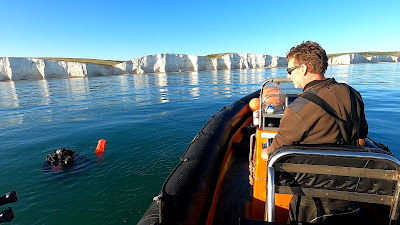 |
| SS Millgate |
The SS Millgate was launched in October 1898 by the executors of Thomas Andrew Walker & Co of Sudbrook, situated along the River Severn. Thomas passed away in 1889, and his executors managed the company until his nephew, Charles Walker, took over the business.
The Millgate was towed for outfitting with machinery and boilers at Roath Dock in Cardiff, and soon after, it commenced service for its new owners, Manchester Coasting & General Shipping Company, Ltd. This company had commissioned several ships from Sudbrook, primarily for trade routes connecting Manchester, the Isle of Man, and Dublin.
In March 1902, reports emerged that the Millgate had a thrilling encounter, being enveloped in fog for three days followed by a collision off Hastings during its journey from Wales to Antwerp. However, Mr. Bowen from the Manchester Coasting and Shipping Company contested this account, clarifying that the Dutch tug Hollander merely approached to inquire about a specific sailing vessel and accidentally came too close, causing damage to the Millgate's amidships bulwark plating. He emphasized that nothing particularly thrilling occurred and that the Millgate was not shrouded in fog for three days, urging for accurate reporting of the facts!
The media in those days was just as bad as now it seems!
The 2nd of November 1905 Millgate docked at St Peter's Port harbor in Guernsey, captained by Procter, with a load of coal destined for the gas company. Afterward, she set sail for St Sampson's port, Guernsey, to take on a new cargo of granite chips bound for Deptford. This cargo, amounting to 460 tons of 'rough shingle,' was supplied by a firm known as Mowlem. A simple search of 'Mowlem and Guernsey' yields results related to granite. The significance of the granite chips cargo will be addressed later.
En route back to Deptford, London, the Millgate encountered rough weather, specifically a full-blown South Westerly gale. The boiler tubes started leaking during the storm, and the ship developed a list to port as the cargo shifted. The Cuckmere Haven Coastguard recognized the peril and notified the Newhaven Lifeboat Station. The maroons were fired, and within 20 minutes, the reserve Lifeboat, Quiver No.1, previously stationed at Margate, was making its way up the river. It headed for the Millgate's rescue just east of Cuckmere Haven with Coxswain Eager and crew aboard, at approximately 7 a.m.
 |
| Surfacing from Millgate -Just East of Cuckmere Haven |
The lifeboat remained on standby for thirty minutes and, observing the worsening list and the imminent danger to those on board, maneuvered closer to rescue the ten crew members of the Millgate. Within less than an hour, the Millgate capsized and sank. It is crucial to note that the Millgate was witnessed capsizing and sinking.
Mr. J J Lines, the Secretary of the Newhaven RNLI, reported the details of the rescue to the RNLI and received a cheque for £7 10s, with an additional 10s per man, as a token of appreciation for the exceptional service provided in rescuing the crew of the Millgate during a gale off Crowlink.
Lloyds was being kept updated on the situation and by 09:30, they were informed that the Millgate, identifiable by its blue funnel with a black top and a white diamond with a 'B', was anchored off Cuckmere Haven in a perilous position, with the Newhaven Lifeboat standing by. By 10:50, the ordeal had ended, and the Millgate had sunk.
The following day, reports indicated that the Millgate was positioned slightly east of Cuckmere Haven, approximately half a mile from the shoreline, and would remain submerged at low tide. The salvage association had been notified and planned to dispatch an assessor the subsequent day to evaluate the circumstances. Throughout this period, a strong southwesterly wind prevailed.
Lloyds sent their agent the next day and he reported the Millgate was on her broadside due to the cargo having shifted and she was laying in 4 fathoms of water, that is just over 7m of water, another important point to remember.
 |
| Not cement |
On the 11th of November, Lloyds received a telegram from the salvage association indicating that the Millgate had shifted slightly, was partially upright, and her masts were visible. Additionally, the steamer from the West England Salvage Company, either Queen of the Isles or Lady of the Isles, had arrived intending to raise the Millgate. However, by the 14th, Captain Anderson from the West England Salvage Company reported that, following a dive, it was discovered that the Millgate was broken in two, dashing all hopes of pumping her out and refloating her.
By month's end, Trinity House had positioned a green wreck buoy 50 meters to the SSW of the wreck in 7 meters of water at low water springs, assuming control over the wreck and its cargo. They also provided the wreck's coordinates, situated just over half a mile offshore. While it appears improbable that Captain Anderson salvaged the Millgate, it has indeed been salvaged, though no records of such an operation exist that I have been able to find. Similarly, records of salvage operations for many local wrecks are absent, yet the evidence suggests that salvage activities were underway. Tides and storms contributing to the process of completely destroying what was left of a ship especially in shallow water like this one
So, why did I say the cargo of granite was important? Well, Kendal McDonald in Dive Sussex has written of the Millgate that "It's clear she has a cargo of cement"
He also describes an upright wreck when the Millgate was seen to roll over plus, he is saying that the wreck is in 22m of water.
He is describing the wreck 2.5 miles South of the Millgate. The Millgate on the Wrecksite chart is a different ship, probably George B Balfour which is upright, does have a cargo of cement and is in 22m of water.
.jpg)

